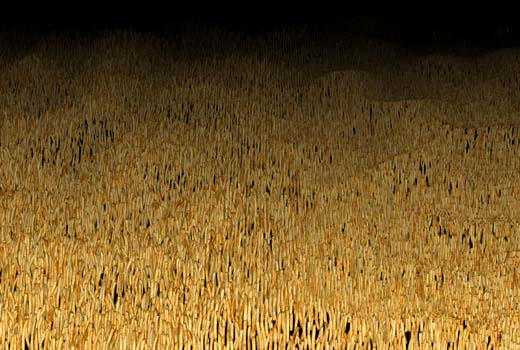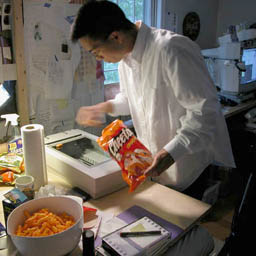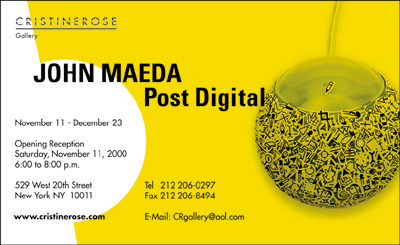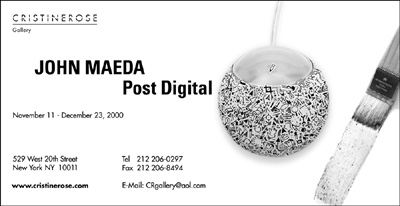| |
Cristinerose / Josee Bienvenu Gallery is pleased to announce the opening of “F00D (F-zero-zero-D),” John Maeda’s
second solo exhibition. Using his fluency in computer programming, combined with his perspective
as one of the world’s top visual designers, Maeda presents 30 new digitally composed photographs that
question the relationships between image, artificial image, and reality.
Featured in the exhibition is the series “Dry and Wet Condiments” that originates from the free packets
of salt,sugar, mustard, and soy sauce that are prevalent in the food service industry. In addition, the
exhibition features digital photographs of color compositions called “Smoothies” based on the colors
and shapes of fruits and vegetables including beets, carrots, apples, pineapples, and avocado.
Maeda spent a year working up ideas for new digital image processes that he could apply to food. This
new body of work focuses on his interest in trying to re-interpret the food we eat in ways that are
relevant, but not completely formulaic. In 2002, he began to write computer programs to implement
these ideas and refine the resulting visual vocabulary.
In the case of the Cibachrome photograph representing sugar granules, Maeda wanted to find some
way to use every little crystal of sugar in one image. Influenced by the idea of nanotechnology —
essentially the ability to paint with atoms — and by his conviction that computer graphics has become
overused and overdeveloped, John Maeda thought it would be interesting to individually place
together each crystal of sugar to obtain an image. The reality of all of the sugar in a sugar packet and
the synthetic nature of three-dimensional computer graphics have come together in a series of highly
saturated, visually captivating photographs.
The content of a single sugar packet was placed onto a scanner bed, and scanned in several passes.
Maeda then created a computer program that was able to extract single images of the sugar crystals
from the scan. To his surprise, Maeda found that in a single crystal packet there are more than
70,000 individual crystals. A computer graphic scene was then specially rendered by another piece
of software he wrote. Finally another computer program he wrote processed the data such that each
‘pixel’ could be replaced with a corresponding sugar crystal cluster. This general process of using
a conventional image scanner as a kind of camera, and the computer programs written by Maeda
as a kind of chemistry for developing the film,repurposes digital photography to illuminate the
relationships between image, artificial image, and reality.
Two small physical installations titled “Egg2-D2” and “Bento Brite” are also included in the exhibition.
These are food-oriented extensions of the work Maeda began in the year 2000 in the “Post Digital”
show at Cristinerose Gallery, where he presented new mixed media constructions, attempting to
establish a relevant relationship between digital technology and the handcrafted object.
John Maeda is Muriel Cooper Professor of Media Arts and Sciences at the MIT Media Laboratory in Cambridge,
Massachusetts. Maeda’s early work redefined the use of electronic media as a core material for expression through
combining skilled computer programming with sensitivity to traditional artistic concerns. He is the 2001 recipient
of the nation’s highest career honor in design — the National Design Award — and Japan’s highest honor — the
Mainichi Design Prize. Maeda is author of two books: Design By Numbers, MIT Press and the 480-page
retrospective MAEDA@MEDIA, Rizzoli/Thames & Hudson. Listed by Esquire Magazine as one of the 21 Geniuses of
the 21st Century, in 2001, Maeda was honored with the world’s largest solo digital media exhibition “Beyond Post
Digital” at the NTT InterCommunication Center in Tokyo.
|





